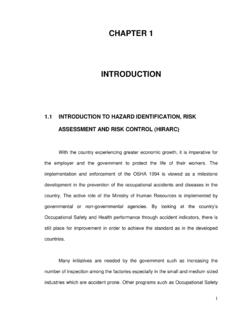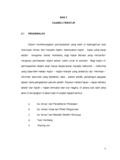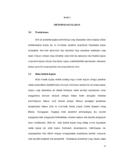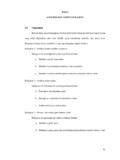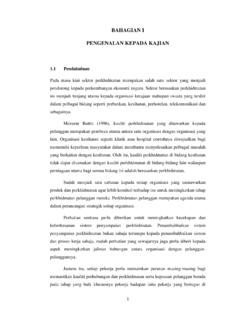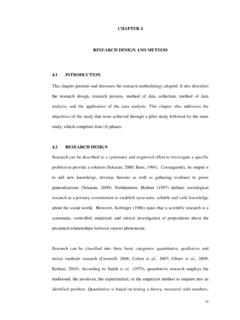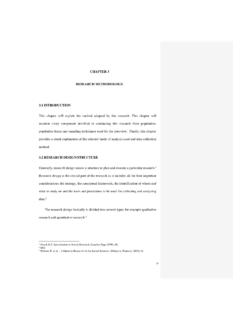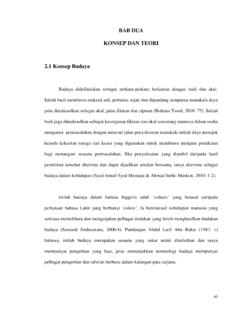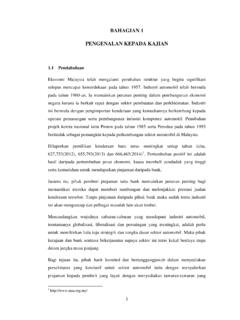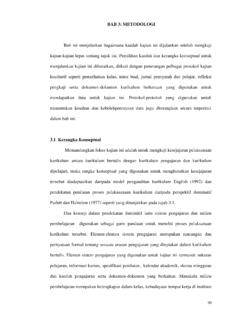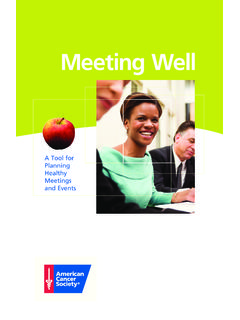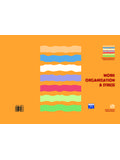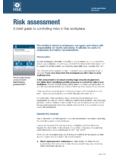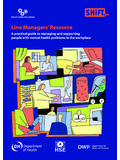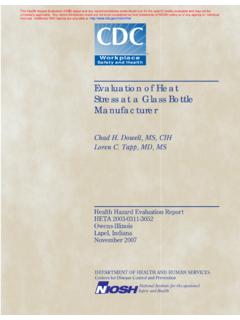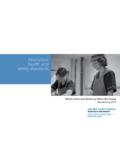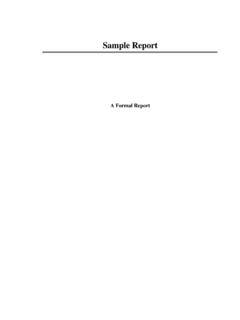Transcription of CHAPTER 2 LITERATURE REVIEW 2.1 Stress at …
1 16 CHAPTER 2 LITERATURE REVIEW Stress at workplace Stress at workplace is often referred to as occupational Stress . The basic rationale underpinning the concept is that the work situation has certain demands, and that problems in meeting these can lead to illness or psychological distress. Occupational Stress is a major health problem for both individual employees and organizations, and can lead to burnout, illness, labour turnover, absenteeism, poor morale and reduced efficiency and performance. Hence, Stress is considered as one of the contributing factors that influenced the efficiency, absentegism, increase in health care costs and other unfavourable results that associated with specific situations, characteristics of the work environment, and individual perceptions and reactions in the context of the workplace (Stacciarini and Troccoli, 2003).
2 According to Lazarus and Folkman (1984), Stress occurs when the demands that are being placed upon a person tax or exceed available resources as appraised by the individual involved. When a stressful situation actually occurs, one often forgets all of the knowledge obtained on Stress and how to effectively manage it. Such a response is part of being human since man is vulnerable like all other living things. The workplace stands out as a potentially important source of Stress purely because of the amount of time that is spent in this setting. However, the Stress inducing features of the workplace go beyond simply the time involved. With the 17financial security and opportunities for advancement of individuals being dependent upon their performance, the pressure to perform often makes the work situation potentially very stressful (Faulkner and Patiar, 1997).
3 Stress in the workplace has become of universal concern to all managers and administrators where in some work groups, Stress has become epidemic. In the United States, health care professionals, technicians, managers of all sorts, military officers, corporate executives, sports coaches, entertainers, farmers, recreational directors and members of the clergy have been identified as being most prone to workplace Stress . By comparison, in Japan, health care providers, production factory workers, VCT workers, salesmen, middle managers of enterprises, and educators at all levels have been identified as being most likely to encounter workplace Stress . However there are differences between Japan and the United States, in regards to work related Stress , likely is due to the cultural differences that exist within the work environments.
4 What workers in one country perceive as stressful, workers in the other country may not perceive as stressful. In addition, the role expectations in the respective work settings are likely to differ between the two countries. Unfortunately, limited research and publications existence that compare work Stress across cultures within the work environment (Lambert and Lambert, 2001). High levels of Stress may also result in increased staff turnover, higher accident rates, more physical ill-health, more psychological ill-health and absenteeism. Absenteeism in particular has become a major concern in industrialized 18countries because of its economical consequences. For instance, sickness absence figures show that the loss of working days for industry in the US amounts to about 550 million (3 7%) each year and for the UK this figure is of the total number of working days (Van Rhenen et al.)
5 , 2007). Stress and job burnout also are related to specific demands of work, including overload, variations in workload, role conflict, and role ambiguity. Workers who perceive a high level of Stress and resulting job burnout have poor coping responses and lack of job satisfaction, which often erode commitment to the organization and lead to higher turnover (Lee and Ashforth, 1996). Abrahamsson (2000) explained that working environment problems should be regarded as production problems in order to achieve the economic gains. Human suffering and economic losses (the loss of man power and productivity, increased cost towards medical expenses, compensation and other hidden liabilities such as replacement labour and modification of workplace ) are the constant reminders to implement better organizational work design, planning of work time, work safety standard and control technologies (Nag and Patel, 1998).
6 Gray (2000) stated that occupational health experts and others concerned with employee health and medical expenses are beginning to recognize that the hidden costs of Stress are enormous. Apparently work-related Stress is estimated to be the biggest occupational health problem in the United Kingdom (UK), after 19musculoskeletal disorders such as back problems and Stress related sickness absences cost an estimated 4 billion annually. How Stress is Caused Signs of Stress can be seen in people s behaviour, especially in changes in behaviour (Table ). Acute responses to Stress may be in the areas of feelings (for example, anxiety, depression, irritability, fatigue), behaviour (for example, being withdrawn, aggressive, tearful, unmotivated), thinking (for example, difficulties of concentration and problem solving) or physical symptoms (for example, palpitations, nausea, headaches).
7 If Stress persists, there are changes in neuroendocrine, cardiovascular, autonomic and immunological functioning, leading to mental and physical ill health (for example anxiety, depression, heart disease). Table : Signs Of Stress How you feel (emotion) How you think (cognitions) Anxious Depressed/tired Angry/irritable/frustrated Apathetic/bored Poor concentration and memory Poor organisation and decision making Less creative in problem solving Hypersensitive to criticism How you behave Your body Have accident/make mistake Eating/sleeping problems Take drugs ( tobacco, alcohol) Problematic social behaviour ( withdrawal, aggression) Sweating, dizzy, nauseous, breathless Aches and pains Frequent infections Asthma, ulcers, skin complaints, cardiac problems.
8 Source: Michie, S .2002. Work causes and management of Stress at work. Occup. Environ. Med. 59;67-72. 20 The degree of Stress experienced according to Michie (2002) depends on the functioning of two protective physiological mechanisms: Alarm reaction . When confronted with a threat to our safety, our first response is physiological arousal: our muscles tense and breathing and heart rate become more rapid. This serves us well when the threat is the proverbial bull in the field rushing towards us. We either fight or flee. Present day threats tend to be more psychological for example, unjustified verbal attack by a superior at work. It is usually not socially acceptable to act by fight or flight , and an alternative means of expressing the resultant emotional and physical energy is required.
9 This falls in the arena of assertive communication. Adaptation . The second adaptive mechanism allows us to cease responding when we learn that stimuli in the environment are no longer a threat to our safety. For example, when we first spend time in a house near a railway line, our response to trains hurtling past is to be startled, as described above. Over time, our response dwindles. If this process did not function, we would eventually collapse from physical wear and tear, and mental exhaustion. Stress is experienced when either of these mechanisms are not functioning properly or when we find it difficult to switch appropriately from one to another. This forms the basis of individual approaches to Stress management.
10 The ability of a person to prevent or reduce Stress is determined by that person s appraisal of:- i. the threat within a situation (primary appraisal), and ii. the appraisal of his/her coping skills to deal with that threat (secondary appraisal). 21 Figure : Model Stress At Work Source: Michie, S .2002. Work causes and management of Stress at work. Occup. Environ. Med. 59;67-72. These appraisals have been shaped by past experiences of confronting Stress and, in turn, influence future behaviour and appraisals. Thus, the process of appraisal, behaviour, and Stress is continuous, and managing Stress can result from changing the way the situation is appraised (cognitive techniques) or responded to (behavioural or cognitive techniques).
